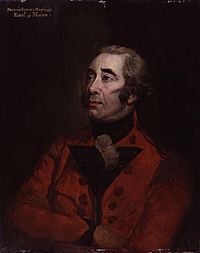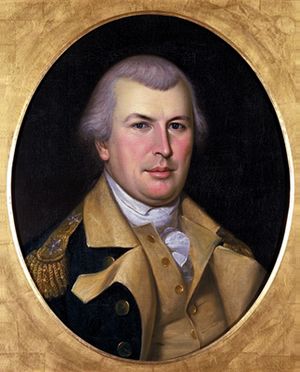Siege of Ninety-Six facts for kids
Quick facts for kids Siege of Ninety-Six |
|||||||
|---|---|---|---|---|---|---|---|
| Part of the American Revolutionary War | |||||||
 Lord Rawdon – lifted the Siege so the Loyalists could escape |
|||||||
|
|||||||
| Belligerents | |||||||
| Commanders and leaders | |||||||
|
|
|||||||
| Strength | |||||||
| 1,000–1,500 | 550 | ||||||
| Casualties and losses | |||||||
| 57 killed 70 wounded 20 missing |
27 killed 58 wounded |
||||||
The Siege of Ninety Six was an important battle during the American Revolutionary War. It happened in western South Carolina in 1781. From May 22 to June 18, 1781, American forces tried to capture a British-held village called Ninety Six.
Major General Nathanael Greene led about 1,000 American soldiers. They surrounded 550 British supporters, known as Loyalists. The Loyalists were defending the village of Ninety Six, South Carolina.
The main fight was around a strong dirt fort called Star Fort. Even though the Americans had more soldiers, they couldn't take the town. They had to stop their attack when British troops led by Lord Rawdon came to help the Loyalists.
Today, the area is a protected place called Ninety Six National Historic Site. It's a special landmark. Many Loyalists who survived the siege later moved to Nova Scotia, Canada. They named their new town Rawdon to remember Lord Rawdon, who saved them.
Contents
Why the Siege Happened
The British had a plan to win the American Revolutionary War. They wanted to control the southern states. They had already taken Charleston and much of South Carolina and Georgia.
But in March 1781, things changed. British General Lord Cornwallis fought American General Nathanael Greene at the Battle of Guilford Court House. Cornwallis won, but his army lost many soldiers. He then moved his troops to Wilmington, North Carolina.
General Greene's army was still strong. He decided to move into South Carolina. His goal was to push the British out of the state.
American fighters, including Thomas Sumter, Francis Marion, and Andrew Pickens, helped. They took over many British outposts in South Carolina. By mid-May, only two main British strongholds remained. These were Ninety Six and Charleston.
Who Fought in the Battle
This battle involved American and British forces. Here's a look at who was there:
American Forces
The American side was led by Major General Nathanael Greene.
- Main Army: This included soldiers from Lee's Legion and the Delaware Regiment. They also had four cannons.
- Militia: Soldiers from the South Carolina Militia, led by Brigadier General Andrew Pickens, and North Carolina Militia joined the fight.
- Maryland and Virginia Brigades: These were two large groups of soldiers. The Maryland Brigade was led by Colonel Otho Holland Williams. The Virginia Brigade was led by Brigadier General Isaac Huger.
British Forces
The British forces were led by Lieutenant Colonel John Harris Cruger.
- Loyalist Regiments: These included the 1st Battalion of De Lancey's Brigade and the 2nd Battalion of New Jersey Volunteers. These were soldiers recruited from Loyalists in New York, New Jersey, and South Carolina.
- Local Militia: Loyalist militia from the Ninety Six District also helped defend the town.
- Cannons: They had three small cannons, but no special artillery soldiers to operate them.
British Defenses at Ninety Six
The British had held Ninety Six since 1780. They had built strong defenses. About 550 experienced Loyalist soldiers defended the outpost.
The main defenses included a palisade (a fence of strong wooden stakes). Around this was a deep ditch. There was also an abatis, which are felled trees with sharpened branches pointing outwards. This made it hard for attackers to get close.
A large fort made of earth, called the Star Fort, was key. It was shaped like a star. This shape allowed defenders to fire at attackers from different angles. This is called enfilade fire. A smaller fort protected the other walls and the water supply. Lieutenant Colonel John Cruger commanded these defenses.
The Siege Begins
General Greene and about 1,000 American soldiers arrived at Ninety Six on May 22. On the same day, Andrew Pickens and Henry "Light-horse Harry" Lee began to besiege nearby Augusta, Georgia.
The Americans immediately started digging trenches. Their chief engineer, Colonel Thaddeus Kosciuszko from Poland, led this work. They focused on attacking the Star Fort.
Colonel Cruger tried to stop the Americans. He often sent out groups of soldiers at night to bother the diggers. Once, his men even chased the workers away and took their digging tools.
By June 3, the Americans had dug a trench very close to the Star Fort. They built a tall wooden tower, about 30 feet high. This tower had a protected platform at the top. From this high spot, American sharpshooters could shoot into the fort.
At first, the snipers in the tower were very effective. They shot many of Cruger's artillerymen. But Cruger quickly responded. He used sandbags to make his fort's walls taller. This gave his own sharpshooters cover. They could then fire back at the tower through small gaps between the bags. Cruger also tried to burn the tower with hot cannonballs, but they didn't get hot enough.
The Americans also shot flaming arrows into the fort. This tactic had worked in other battles, like the Siege of Fort Motte. They hoped to set the buildings inside the fort on fire. But Cruger had his workers remove the roofs from the buildings. This stopped them from burning.
On June 7, Lord Rawdon left Charleston with 2,000 British soldiers. He was coming to help the Loyalists at Ninety Six. The next day, Pickens and Lee arrived at Ninety Six. They had successfully captured Augusta on June 6.
Greene didn't find out about Rawdon's approach until June 11. With Rawdon getting closer, Greene decided to try a direct attack on the fort. Cruger learned about Rawdon's approach the next day. A messenger, pretending to be an American, got close enough to the fort to race the rest of the way on his horse.
The Assault
Greene planned a two-part attack for June 18. One group would capture the smaller fort. A larger group would attack the Star Fort. Some men would pull down the sandbags there. This would expose the defenders to fire from the American tower.
When the attack began, it went well at first. The smaller fort was taken. Soldiers successfully got past the abatis and pulled down the sandbags. But then, Cruger launched a counterattack. He sent out two groups of soldiers, called sorties. They attacked the American soldiers from the sides.
It was a fierce fight, with soldiers using bayonets and their muskets as clubs. The American leaders of the attack were killed. Their men were forced to retreat back to their trenches. With the attack failing, and Rawdon only 30 miles away, Greene stopped the assault. He ordered his troops to retreat.
After the Battle
The Americans lost about 150 men in the siege. The Loyalists lost fewer than 100. General Greene retreated towards Charlotte, North Carolina. This allowed Rawdon to meet up with Cruger.
Rawdon sent a large force to chase Greene. But the hot weather and long marches slowed them down. The British force was called back to Ninety Six. Rawdon then decided to abandon Ninety Six.
General Greene felt that the failure at Ninety Six was partly due to Sumter and Marion. He believed they didn't support his operations quickly enough. Other officers later thought Greene and Lee should have cut off the defenders' water supply.
In his writings, Henry Lee blamed Colonel Kosciuszko for much of the defeat. He thought the first trench was dug too close to the Star Fort. He also believed Kosciuszko didn't realize how long it would take to dig in the hard ground. Even with these issues, Greene praised Kosciuszko's efforts. He noted that with more time, Kosciuszko's plan might have worked.
When Greene learned Rawdon was leaving Ninety Six, he tried to gather all American forces. He wanted to attack Rawdon before he reached Charleston. But he failed because Sumter and Marion were slow to move. Greene rested his men for most of July and August. They were in the High Hills of the Santee. He fought the British again near Charleston at the Battle of Eutaw Springs on September 8, 1781. This was the last major battle in the South.
Legacy
Ninety Six National Historic Site was named a National Historic Landmark in 1973. This means it's a very important historical place.
Many Loyalists saved by Rawdon during the siege were given new land by the British Crown. They settled in Nova Scotia, Canada. They named their new town Rawdon, Nova Scotia, after Lord Rawdon. This was to honor him for rescuing them. The entire De Lancey's Brigade, which protected the Loyalists, was disbanded in Woodstock, New Brunswick, Canada, in 1783.
Images for kids




